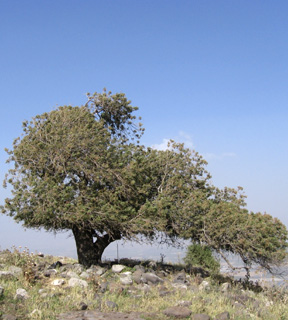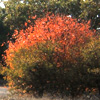Atlantic Pistacia is a large deciduous tree. It has a thick trunk, and the diameter of a mature tree can reach up to 2.5 meters. The crown of the tree is wide, mushroom-shaped and reaches a height of 15 meters and a diameter of 30 meters. It tends to grow in the shape of a tree (and not as its relative Terebinth [Pistacia palaestina], which tends to degenerate into a shrub after being damaged by fire or by animal browsing). It grows rapidly, and the trunk thickens impressively within a few years. The sight of its trunk causes people to exaggerate the estimates of its age. Scientists have not dated any tree beyond 600 years.
The leaf is pinnate, with 3-5 pairs of leaflets, and a single leaflet at the tip. The leaflets are leathery, 2.5-7 cm long, its margins are entire, with a rounded tip. The leaf axis is not round, but with flat margins. The leaves turn red at the end of the summer, before leaf shedding. At the beginning of the spring growth of this tree it is also red.
Pistacia atlantica blooms in March-April. The tree is dioecious. The flowers are arranged in dense panicle-like inflorescences. The flowers are small and numerous. The perianth is simple, with a calyx, and no corolla. The female flowers have a calyx with 3-5 lobes. The male flowers contain 3-6 stamens. The flowers are pollinated by wind. The fruits are arranged in loose racemes, seed contaning fruits change to dark blue color when they ripen. Empty fruits are red. The single fruit is a round single-seed drupe with a diameter of 6-7 mm, and is edible after roasting. It is also used as a spice.
Pistacia atlantica often grows together with Mount Tabor Oak in a flora formation called “Forest-Park”. This is a floral landscape of sparse trees (only about a tenth of the surface is covered by the shadow of trees), but each individual is a magnificent, mature tree with a clear trunk and semi-spherical crown. Typical examples are known from the Yehudiya Forest in the Golan Heights, in the Kadesh Valley in the Galilee, in the Hula Valley and in the western Lower Galilee, sometimes accompanied by trees such as Officinal Styrax and Judas Tree. The tree is common in Israel, especially along a diagonal line from north-northeast to south-southwest, near the transition line from Mediterranean flora to Irano-Turanian flora. Thus it is found in the Hula Valley in a Mediterranean Forest-Park created by the Mount Tabor Oak association, whereas in the Negev Highlands, in the Irano-Turanian and desert area, it grows on the tops of mountains, in seasonal streams, and in cracks in rocks. Its global distribution spreads from the Atlas Mountains in the west (which is the origin for this species’ name) to central Asia in the east.
The fruit is used for extraction of oil for domestic use, for medicine and for lighting. The resin is used for producing turpentine for industrial and medical use. The wood is used for woodturning (giant wood screws of oil presses in the Golan are made from its wood). The tree can serve as a rootstock for Pistacia vera (Pistachio).
Pistacia atlantica is infected by the Slavum wertheimae aphid which causes it to produce galls in the shape of a Stylophora coral that may reach the size of a fist. The galls are coral-red and gradually turn brown-black. The galls and the trunk were used to extract tanning materials and resin for medical use.
The tree is protected by law.
The tree is mentioned often in the Bible, and it is customarily identified with this genus. The Hebrew name is derived from Providence, an allusion to the sacredness of the tree in antiquity.
The genus includes 9 species, 3 of which grow in Israel.
Written by Erga Aloni and Mike Livne







 תפריט נגישות
תפריט נגישות







